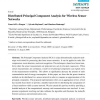157 search results - page 14 / 32 » Applying Discrete PCA in Data Analysis |
SCIA
2007
Springer
14 years 1 months ago
2007
Springer
Abstract. Moving objects detection is a crucial step for video surveillance systems. The segmentation performed by motion detection algorithms is often noisy, which makes it hard t...
CSDA
2008
13 years 7 months ago
2008
Semi-continuous data arise in many applications where naturally-continuous data become contaminated by the data generating mechanism. The resulting data contain several values tha...
CORR
2010
Springer
13 years 7 months ago
2010
Springer
Abstract: The Principal Component Analysis (PCA) is a data dimensionality reduction technique well-suited for processing data from sensor networks. It can be applied to tasks like ...
COCOA
2008
Springer
13 years 9 months ago
2008
Springer
A popular model for protecting privacy when person-specific data is released is k-anonymity. A dataset is k-anonymous if each record is identical to at least (k - 1) other records ...
SIGDIAL
2010
13 years 5 months ago
2010
A central problem in Interactive Question Answering (IQA) is how to answer Follow-Up Questions (FU Qs), possibly by taking advantage of information from the dialogue context. We a...

